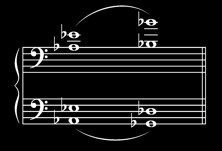Music From Numbers
For the past 15 years, my electronic music has focused on creating music from numbers. I use computers to turn mathematical ideas–number sequences, equations, data, and so forth–into music. Each composition begins as an experiment in sound that asks the question:
What would this mathematical idea sound like?
All of the works on this CD are algorithmic compositions based on isomorphisms between numbers and sound. Any mathematical function may be turned into an algorithm capable of generating music. It is also important for the listener to know that a wide variety of real-time interaction models between composer, performer and machine were employed in the realization of these works. Some of these techniques are described in the notes that follow.
The album’s title, Sounding Number, was derived from the Latin term numerus sonorous. Renaissance music theorist Gioseffo Zarlino used it to refer to the neo-Pythagorean belief in an almost magical relationship between music and number. The emerging science of auditory display was also a source of inspiration and ideas. Just as one graphs an equation in the geometric plane, one may sonify an equation in the domain of sound in order to learn more about its structure. In many cases, the ear can perceive gradations not perceivable by the eye. In the field of auditory display, the term sonification is used to refer to the process of mapping data to sound for scientific purposes. I, however, use sonifications as the basis for musical compositions.
The first step in my compositional process is to use a musical programming language (I used Max/MSP and Csound on this album) to write a computer program that allows me to efficiently explore the myriad ways a particular mathematical idea may be turned into music. Dozens of trials and corresponding revisions to the program are required before the experiment begins to produce interesting results. Numbers are strategically mapped onto musical parameters such as pitch, intensity, timbre, and spatial location in order to create musical ideas. Once the initial experiment yields what I deem to be viable musical results, I tear down the experimental scaffold and build a new, more complex, algorithmic implementation that allows me to interactively collaborate with the computer to compose a full-length composition. I call this computer-aided compositional process musical sonification. As you listen to the album, you will encounter musical sonifications of prime numbers, Fibonacci numbers, triangular numbers, the golden ratio, the logarithmic spiral, fractals, chaos theory, the digits of pi, and more. I hope you enjoy the works on this CD and the mathematical ideas that inspired them, ideas encoded within the many levels of the music’s structure.
RB




